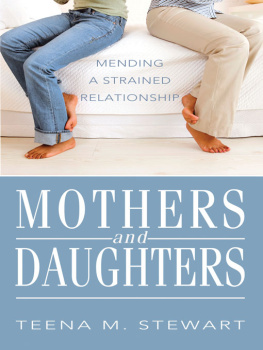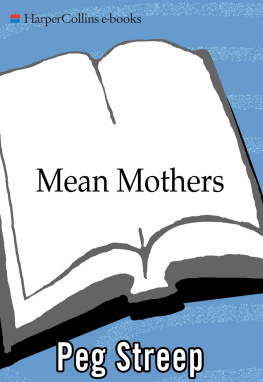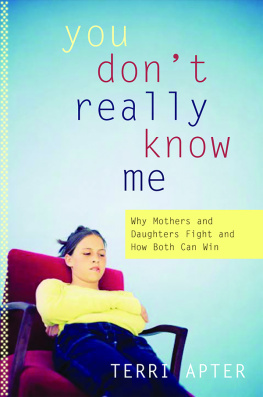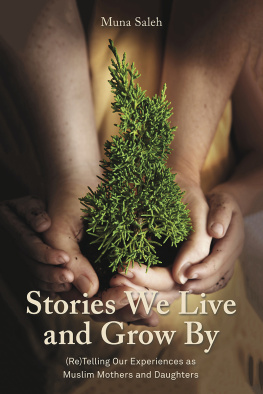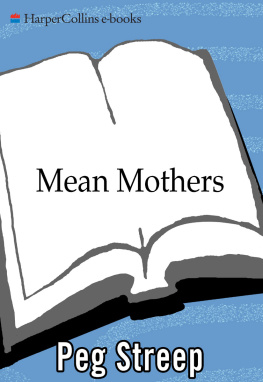
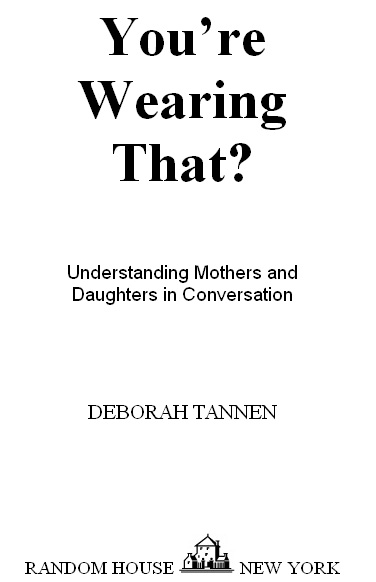
Contents
In memory of my mother
Born DINA ROSIN
Minsk, Russia
May 3, 1911
Died DOROTHY TANNEN
USA
July 23, 2004
PREFACE
T hey are the best of conversations; they are the worst of conversations. Talk between mothers and grown daughters can be both: a remark coming from your daughter or your mother is more healing or more hurtful than the same remark coming from someone else. The relationship between mothers and daughters is the literal mother of all relationships. It is among the most passionate of womens lives, the source of the deepest love and also the deepest angereven hatethat most women experience. It brings us face-to-face with reflections of ourselves and forces us to confront fundamental questions about who we are, who we want to be, and how we relate to others both within and outside our families.
The mother-daughter relationship continues to hold tremendous power throughout our livesfor daughters, long after we are grown and even after our mothers are gone; for mothers, long after daughters have become adults and, in some cases, mothers themselves. Words exchanged between daughters and mothersin the moment or in memorycan carry enormous weight. In You Just Dont Understand I showed how women and men can walk away from the same conversation with completely different ideas of what was said and what was meant. The same is true for conversations between mothers and grown daughters, even though both are women and in many ways speak the same languageindeed, partly because both are women and in many ways speak the same language: a language in which intimacy and closeness as well as power and distance are constantly negotiated. Improving communication between mothers and daughters, much like breaking down barriers to communication between women and men, requires, above all, understanding: seeing the situation from the others point of view. In this book I provide that understanding as well as concrete suggestions for improving mother-daughter conversations and therefore relationships.
The challenge in every relationship, every conversation, is to find ways to be as close as you want to be (and no closer) without that closeness becoming intrusive or threatening your freedom and your sense that you are in control of your life. In this, relationships between daughters and mothers are like all relationships, only more so. They combine, on one hand, the deepest connection, the most comforting closeness, with, on the other, the most daunting struggles for control. Each tends to overestimate the others power while underestimating her own. And each yearns to be seen and accepted for who she is while seeing the other as who she wants her to beor as someone falling short of who she should be.
Women are healed by, or ache for, satisfying conversations with their mothers and grown daughters, in some cases to build on already excellent relationships, in others to break out of cycles of misunderstanding that can turn amiable conversations into painful or angry ones in the blink of an eye. Both want to maximize the gifts of rapport and closeness while minimizing the inevitable hurts that come along with any close relationship but can be especially intense in this one.
Youre WearingThat? grows out of my last book in much the same way that You Just Dont Understand grew out of the book that preceded it. My first general-audience book, Thats Not What I Meant!, introduced my concept of conversational style and illustrated its power in every aspect of our daily lives. Of the books ten chapters, the one that got the most attention and the most enthusiastic response was the chapter devoted to conversations between women and men. That led me to turn my research to the topic of male-female communication and to write You Just Dont Understand: Women and Men in Conversation. In a parallel way, of the nine chapters in I Only Say This Because I Love You, a book about adult family relationships, the one that got the most attention was Im Still Your Mother, and the parts that most captivated readers were those devoted to the complex and superloaded relationship between mothers and adult daughters. Prompted by this response, as well as by my desire to get to the bottom of my evolving relationship with my own mother, I turned my research to conversations between mothers and daughters in order to delve more deeply into this uniquely intense relationshipone that continues to evoke powerful emotions long after it has ceased, ostensibly, to be the center of our personal lives.
Much of what I say about mother-daughter conversations is also true of talk between mothers and sons, fathers and daughters, and fathers and sons. By focusing on daughters and mothers, I do not mean to deny this. I have not conducted a comparative study. As a professor of linguistics specializing in sociolinguistics, I use a case-study method in my research. Reflecting the linguistic part of sociolinguistics, I base many of my findings on close analysis of transcribed, tape-recorded conversations. Reflecting the socio side, I also analyze conversations I am party to or overhear, much as some sociologists or anthropologistslike fiction writersbecome observers and analysts of the interactions around them. Many of the examples I present are reconstructed from interactions I took part in, overheard, or was told about. Any conversation I encounter, with people I know well or have just met, is a potential source of examples, as women who hear the topic of my book often volunteer their own experiences. The foundation of my research, however, is close analysis of transcribed audiotaped conversations. In this book too I analyze word-for-word transcriptions of conversations that were tape-recorded by students in my classes in connection with written assignments they handed in as part of their coursework and gave me permission to use.
I also arranged to have more focused conversationsinterviews, you might call themwith women I knew, and women they knew, in order to hear in more depth about their experiences with their mothers and daughters. When I talked to someone in person, I audiotaped the conversation and had it transcribed; when I talked to someone over the phone, I wore headphones and typed notes as we spoke; and when interchanges took place on e-mail, I printed them. In several cases I spoke to a mother and then, separately, to her daughter or vice versa. In two instances, I talked to groups of women together at meals hosted by women I knew to which they had generously invited friends I did not know. My interviews (conversations, really, because I did not ask a preset series of questions) included women of a range of ages, races, and ethnic groups. But I did not attempt to make generalizations about members of groups, so I dont specify the race or ethnicity of women whose experiences I include, although many of the examples I present come from Asian-American and African-American as well as European-American women and, for that matter, from deaf as well as hearing women, and lesbian as well as straight women.
I never use an example without getting permission from the person who was its source. So that people will speak freely to me, and simply as a matter of integrity (using my students, friends, and family as sources of data might otherwise seem somewhat vulturish), I always let people see how I intend to use their life experiences, in order to make sure that I got them right and to confirm whether they want to be identified by name or pseudonym. Pseudonyms are always first name only; when I identify the source of an example, I use both first and last names.
Next page



